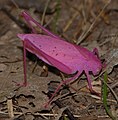Erythrism

Erythrism or erythrochroism refers to an unusual reddish pigmentation of an animal's hair, skin, feathers, or eggshells.[1]
Causes of erythrism include:
- Genetic mutations which cause an absence of a normal pigment and/or excessive production of others[2]
- Diet, as in bees feeding on "bright red corn syrup" used in maraschino cherry manufacturing.[3]
Erythrism in katydids has been occasionally observed. The coloring might be a camouflage that helps some members of the species survive on red plants.[4] There is also consensus that the erythristic mutation is actually a dominant trait among katydid species, albeit a disadvantageous one, due to the overwhelmingly green coloration of most foliage. Hence, most pink or otherwise vividly colored katydids do not survive to adulthood, and this observation explains their rarity.[5] Erythrism in leopards is rare, but one study[6] reported that two of twenty-eight leopards seen in camera traps in a South African nature reserve were erythristic, and the authors found records of five other "strawberry" leopards from the region.[7]
Gallery
[edit]- Erythrism in katydids
See also
[edit]References
[edit]- ^ Dariusz Bukaciński and Monika Bukacińska (1997), "Production of Erythristic Eggs by the Black-Headed Gull in Poland", Wilson Bull., 109 (1), Wilson Ornithological Society: 177–182, JSTOR 4163790
- ^ Helen Hays and Kenneth C. Parkes (1993), "Erythristic Eggs in the Common Tern", J. Field Ornithol., 64 (3), Association of Field Ornithologists: 341–345, JSTOR 4513830
- ^ Schmidt, Sarah (December 1, 2010). "Helping Brooklyn's Red Stingers Get Off The Juice". onEarth. Archived from the original on December 24, 2010.
- ^ Gary Noel Ross (1 June 2003), "Pretty in pink", Natural History
- ^ Stone, Daniel (March 2013). Easier Being Green. National Geographic. p. 19.
- ^ Pirie, Tara J.; Thomas, Rebecca L.; Fellowes, Mark D. E. (2016-05-20). "Erythristic leopards Panthera pardus in South Africa". Bothalia. 46 (1): 5. doi:10.4102/abc.v46i1.2034. ISSN 2311-9284.
- ^ "Ultra-rare 'strawberry' leopards discovered in South Africa (Photos)". Earth Touch News Network. Retrieved 2020-02-29.
External links
[edit]- The Mystery of the Red Bees of Red Hook, The New York Times, November 30, 2010
- Rare Pink Katydid Discovered in Northern Illinois, Chicago Tribune, August 10, 2011
- Another Nice Example of Erythrism: Grasshopper, August 28, 2009
- Erythrism: Grasshopper in New Zealand, Rod Morris, 2010
- Pink Animal Amazingness Archived 2008-12-23 at the Wayback Machine, Paula Kashtan, lemondrop.com, December 18, 2008




